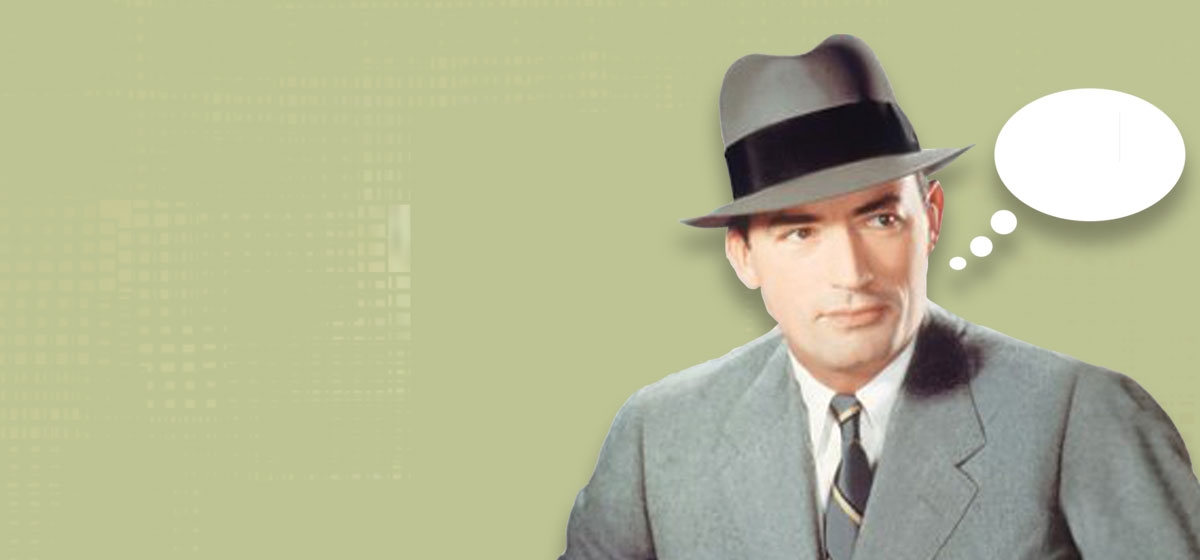Whatever Happened to the Man in the Gray Flannel Suit?

In 1955, Sloan Wilson wrote a groundbreaking novel on the trials of working in the 1950s. “The Man in the Gray Flannel Suit” became a hit film starring Gregory Peck and tells the story of how a young executive works tirelessly in what would become known as the white-collar world.
Wilson’s protagonists are Tom and Betsy Rath, a couple struggling with tending their growing family in suburban obscurity. In the mid-50s, the Rath character inspired many to become hard-working “company men.”
Wearing the uniform of a dark suit, tie and always a fedora, the company man was a no-nonsense executive who analyzed problems, ran solutions up the flag pole, modernized production and followed the rules. Hard work and patrician values led to a happy life and a comfortable retirement produced by a well-earned pension.
Sound idyllic? Perhaps quaint? Certainly less complicated, right? Tom and Betsy Rath had it pretty good in hindsight. Or did they? With all the changes that have taken place, 50 years ago is farther away than it seems. What was it really like living and doing business back then? Was the slower pace easier? Would Tom and Betsy recognize our world? Let’s find out.
Debt and taxes
Despite the fact that the cost of living was higher in the ‘50s, people didn’t face the debt that looms today. In 1959, personal income was roughly twice the debt people carried. Today most Americans’ debt equals their annual income, according to Business Week. And the average American now carries $8,562 in credit card debt alone.
Despite a lower debt load, however, workers in the 1956 had to put in more hours for their goods than we do today. “(We work) 300 hours less than a man in the 1950s to pay for a family car,” wrote Stuart A Kallen in “Through the Decades: The 1950s.” “A fifties worker worked 6.5 hours per square foot for his home versus 5.6 hours per square foot.”
Of course, if you were rich in the 1950s, you weren’t a happy camper. The tax rate for the highest 1 percent of wage earners was 88 percent back then.
The looming menace
In the mid-50s, people were afraid of an enemy that they did not know and did not understand. In October 1957, when Communist Russia launched Sputnik I, the first artificial satellite, it didn’t prompt celebration for this scientific advancement. The size of a basketball, Sputnik I sent waves of fear across the United States as people realized that it could be a delivery system for a nuclear warhead. Elementary school teachers soon taught children to “duck and cover” under their desks during air raids as their parents built fall-out shelters in the back yard.
Terror about the Stalinist red menace made J. Edgar Hoover’s wiretapping and the blacklisting by Sen. Joseph McCarthy and the House Un-American Activities Committee seem acceptable. It all came to a halt when CBS’s Edward R. Murrow and Fred Friendly courageously said, “good night and good luck” to the junior senator from Wisconsin.
Today, our threat is mostly faceless with the exception of an unusually tall Arab on a dialysis machine. From perceived abuses of the Patriot Act to the debate over the legality of torture and humiliation as seen at Abu Ghraib and incarcerations at Guantanamo Bay, even the most stalwart of conservative legislators are asking if we have gone a little too far in the name of national security. It has taken John McCain, a Republican senator, who was himself a victim of torture as POW in Vietnam, to say enough is enough.
The Pittsburgh picture
In 1956, the big name in Pittsburgh business was Richard King Mellon, who owned significant stakes in many of the city’s big companies, in addition to his Mellon Bank stock. When you went to work in 1956 Pittsburgh, chances are you made things. The big employers were U.S. Steel, Allegheny Ludlum Steel, Gulf Oil, Dravo, J&L Steel, Westinghouse, Westinghouse Air Brake, the Blaw-Knox Company and Koppers.
In the Pittsburgh of the mid-50s, the local press heralded a group of business leaders led by R.K. Mellon for their economic development efforts. The members of the powerful Allegheny Conference on Community Development controlled their companies. They did what they wanted. They were decisive. Along with powerful mayor David L. “Don’t Call Me Boss” Lawrence, the coalition made sweeping changes, from flood and smoke control to the creation of Point State Park. The Pittsburgh Renaissance became a national model.
Today, Mellon Financial isn’t really a bank. It makes fees on investment transactions and financial services. Pittsburgh’s big corporate newsmakers are Jim Rohr from PNC and Jeff Romoff of UPMC.
A lot of Pittsburgh’s big ’50s companies still exist, but many are overshadowed by service and retail organizations such as UPMC, PNC, Federated Investors, American Eagle Outfitters, Mellon, Dick’s, iGate, Education Management Corporation and Highmark.
Today, economic development is fragmented among numerous groups. Allegheny Conference members are CEOs of public companies, beholden to shareholders. For many groups funded by government and foundations, red tape and consensus inhibit bold action. Political sands have shifted as well. Lawrence presided over a city of more than 650,000. Today, Bob O’Conner governs about half as many and now Allegheny County Executive Dan Onorato has the bigger role with a county population of about 1.3 million.
The whiz kids
In the mid-’50s, a brash young group of business intelligentsia was poised to rule the world.
In his book, “The Best and The Brightest”, David Halberstam writes about these famed Whiz Kids, a group of statistical savants from Harvard Business School’s faculty. They had been recruited by the Army during World War II to develop a plan to build our armed forces.
Robert McNamara, epitomized the Whiz Kids’ “discipline, concentration and relentless work all day and night” ethic, Halberstam said. “That work ethic grew the Army Air Corps from 295 pilots the year before Pearl Harbor to 96,000 the year after.”
After World War II, they were marketed to corporations as a group, eventually finding their home at the Ford Motor Company. Salted among its executive ranks, the Whiz Kids transformed and re-tooled Ford to make it a powerhouse and change the face of American business. McNamara became an almost mythic figure rising to Ford’s top ranks before being recruited for public service.
Today, there are no pensions rewarded to “company men” like McNamara and Tom Rath. Our heroes are not corporate men, but entrepreneurs of all sexes, shapes and colors. A Gallup study found that 50 percent of the adult population of the United States wanted to be entrepreneurs.
For the first time in the country’s history, there are more millionaires in America 50 years and younger than 50 years and older. Forbes reports that by the late 1990s, 72 percent of the 400 richest Americans are first generation millionaires. Today’s Whiz Kids are Google Guys Larry Page and Sergey Brin, Michael Dell, eBay’s Meg Whitman, and Jeff Bezos of Amazon.com. Pittsburgh’s new ecomony Whiz Kids include Glen Meakem of Freemarkets, Ron Bianchini of Spinnaker Networks, Sean McDonald of Automated Health Care, Ron Morris of J.D. Warren, Lou Wheeler of Rapidigm, and Eric Cooper’s gang from Fore Systems.
Interstate and cell phones
In the ’50s, the opiate of the people was television. According to Stuart A. Kallen’s “The 1950s,” television growth exploded in the decade of Uncle Miltie and Liberace. The number of TV sets grew from 7,000 in 1946 to 50 million by 1960.
Today, people question which technology we are more addicted to: the cell phone, the Internet or the Internet-enabled cell phone. Now, 140 million Americans, or 59 percent, own a cell phone. And some even refer to their favorite personal digital assistant (PDA) as “Crackberry.”
In the 1950s, the big project connecting people to each other and building commerce was the construction of the Interstate Highway system. The Federal-Aid Highway Act of 1956, Eisenhower’s great achievement, led to 40,000 miles of new highway. Pennsylvania added 1,500 miles of its own, led by the 313-mile Keystone Shortway, now known as I-80. Today, the great connectivity frontier is “convergence,” the combining of wireless transmission, content and hand-held computers. We’ll no longer carry our laptops, cell phones, personal digital assistants and portable DVD players in a big black bag. They’ll all be clipped to our belts.
Peyton Place, Wisteria Lane
As you rode the train to work in 1956, you probably hid your copy of a pot-boiler about a small New England town in your briefcase. Written by Grace Metalious, it was a steamy saga called “Peyton Place,” which chronicled the life and loves of Allison McKenzie, Selena Cross and Rodney Harrington. A best seller before it hit bookstores in September of that year, “Peyton Place” eventually sold more than 12 million copies. The television version starring Ryan O’Neal, Barbara Parkins and Mia Farrow made $62 million for its network.
Today as you stand in line waiting for your skinny, double-shot grande, you’ll freely admit to knowing the décor of every house on Wisteria Lane, the home of our favorite desperate housewives. By comparison, in terms of steam and relative earning power, the exploits of Bree, Susan, Lynette and Edie are pretty tame. “Peyton Place” was branded filth by almost every reviewer. Compared with Peyton Place’s “good parts,” which were ’50s code words for sex scenes, the murders and basement incarcerations of “Desperate Housewives” seem like an ABC After School Special.
I still like Ike
On balance, things are surprisingly similar to 1950s life. People want their slice of the American Dream. They want to fit in, and they want to get ahead. They enjoy new gadgets. They like a good yarn. They are afraid.
Perhaps the history professors weren’t fooling. History does seem to repeat itself, though there are some stark differences between 1956 and 2006. Everything moves a little too fast now, we are under a lot of pressure and we sure like to overextend ourselves financially.
So maybe it might not be a bad idea to call up Marty McFly and ask him to take you for a spin in his souped-up DeLorean. Wouldn’t it be kind of nice to sit on the porch some night and listen to Bob Prince doing Pirates play-by-play on the radio?





